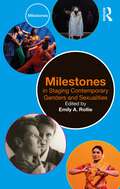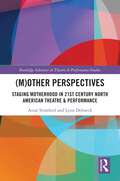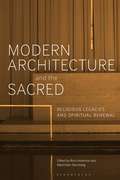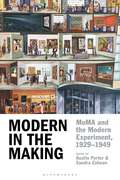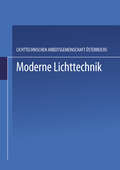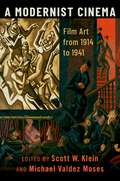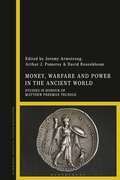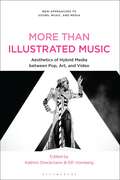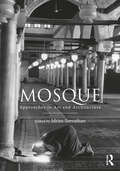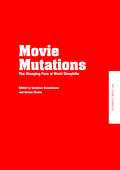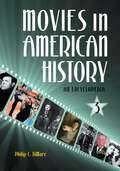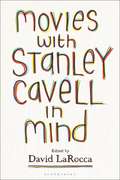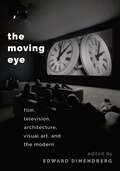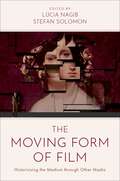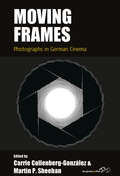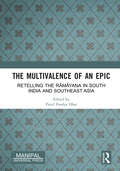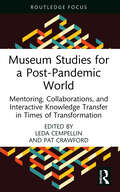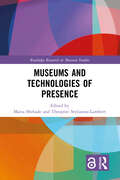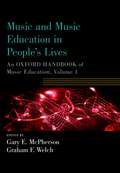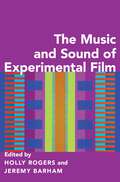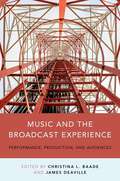- Table View
- List View
Milestones in Staging Contemporary Genders and Sexualities (Milestones)
This introduction to the staging of genders and sexualities across world theatre sets out a broad view of the subject by featuring plays and performance artists that shifted the conversation in their cultural, social, and historical moments.Designed for weekly use in theatre studies, dramatic literature, or gender and performance studies courses, these ten milestones highlight women and writers of the global majority, supporting and amplifying voices that are key to the field and some that have typically been overlooked. From Paula Vogel, Split Britches, and Young Jean Lee to Werewere Liking, Mahesh Dattani, Yvette Nolan, and more, the chapters place artists’ key works into conversation with one another, structurally offering an intersectional perspective on staging genders and sexualities.Milestones are a range of accessible textbooks, breaking down the need-to-know moments in the social, cultural, political, and artistic development of foundational subject areas.
**Missing**: Staging Motherhood in 21st Century North American Theatre & Performance (Routledge Advances in Theatre & Performance Studies)
This anthology examines maternity in contemporary performance at the intersection of a wide range of topics from nationhood to mental health, queer parenting, embodied dramaturgy, cultural practice, and immigration. Across the breadth of these themes, we interrogate the cultural implications and politics of how we script, perform, receive, and define mothers, challenging many of the normalizing and patriarchal tropes associated with the mother-as-character. This book includes critical essays examining twenty-first century dramatic literature, first-hand ethnographic accounts of motherhood in practice, interviews, feminist manifestos, and artist reflections. In its deliberately curated variety, this collection seeks to resist homogeneity and offer instead a range of approaches to key questions: what versions of motherhood get staged, and why? And how do dramatic representations tell us about the role of mothers in our own fraught contemporary moment? This collection will be of great interest to those in academia who are teaching, researching, or studying in the fields of Theatre and Performance Studies, American Studies, and Feminist and Gender Studies.
Mit eigenen Augen / With Their Own Eyes: KünstlerInnen aus der ehemaligen Meisterklasse Maria Lassnig / Former Students of Maria Lassnig (Edition Angewandte)
Die Universität für angewandte Kunst Wien ehrt mit dieser vorliegenden Publikation eine herausrag- de Lehrerin, die fast zehn Jahre an diesem Haus unterrichtete. Maria Lassnig, die wohl zu den bed- tensten und erfolgreichsten österreichischen Künstlerinnen der Gegenwart zählt, leitete von 1980 bis 1989 die Meisterklasse für experimentelles Gestalten. Lassnig ermutigte ihre Studentinnen und Studenten immer wieder zur Entwicklung kreativer Visionen und zum künstlerischen Experiment. Sie hat als eine herausragende Künstlerpersönlichkeit ihre Schülerinnen und Schüler mitgeformt, geprägt, gefördert und ihnen dennoch genug Freiraum für die eigene Entfaltung und künstlerische Weiterentwicklung gewährt. Im Mittelpunkt ihrer Lehre standen immer wieder der Körper und dessen Abbildung. Die Sensibilisierung der Studierenden hin zum bewussten Sehen, die Schärfung der Konzentration auf das kleinste Detail waren ihr ein großes Anliegen. Anlässlich der Ausstellung "Mit eigenen Augen", die von Maria Lassnig kuratiert wurde, e- stand diese Publikation. Gezeigt und vorgestellt werden Arbeiten ihrer früheren Schülerinnen und Schüler, die sich nicht nur auf Malerei beschränken, sondern auch Skulptur, Installation und Animationsfilm miteinbeziehen. In dieser vorliegenden Publikation, die in enger Zusammenarbeit mit dem Springer-Verlag entstanden ist, wird eine bemerkenswerte und vielfältige Auswahl von Arbeiten der ehemaligen StudentInnen und AbsolventInnen aus der Klasse Maria Lassnig vorgestellt. Es wurde ein Buch über ein Kapitel in der Geschichte der Angewandten, an der die Bildende Kunst einen unverzichtbaren Stellenwert hat. Das Zustandekommen dieser Publikation ist ein wunderbares Beispiel dafür, wie ein Austausch, eine Vernetzung zwischen der Universitätund bereits erfolgreich im Beruf stehenden Absolventinnen und Absolventen funktionieren kann.
Modern Architecture and the Sacred: Religious Legacies and Spiritual Renewal
This edited volume, Modern Architecture and the Sacred, presents a timely reappraisal of the manifold engagements that modern architecture has had with 'the sacred'. It comprises fourteen individual chapters arranged in three thematic sections – Beginnings and Transformations of the Modern Sacred; Buildings for Modern Worship; and Semi-Sacred Settings in the Cultural Topography of Modernity. The first interprets the intellectual and artistic roots of modern ideas of the sacred in the post-Enlightenment period and tracks the transformation of these in architecture over time. The second studies the ways in which organized religion responded to the challenges of the new modern self-understanding, and then the third investigates the ways that abstract modern notions of the sacred have been embodied in the ersatz sacred contexts of theatres, galleries, memorials and museums. While centring on Western architecture during the decisive period of the first half of the 20th century – a time that takes in the early musings on spirituality by some of the avant-garde in defiance of Sachlichkeit and the machine aesthetic – the volume also considers the many-varied appropriations of sacrality that architects have made up to the present day, and also in social and cultural contexts beyond the West.
Modern in the Making: MoMA and the Modern Experiment, 1929–1949
Today the Museum of Modern Art is widely recognized for establishing the canon of modern art; yet in its early years, the museum considered modern art part of a still unfolding experiment in contemporary visual production. By bracketing MoMA's early history from its later reputation, this book explores the ways the Museum acted as a laboratory to set an ambitious agenda for the exhibition of a multidisciplinary idea of modern art. Between its founding in 1929 and its 20th anniversary in 1949, MoMA created the first museum departments of architecture and design, film, and photography in the country, marshaled modern art as a political tool, and brought consumer culture into a versatile yet institutional context. Encompassing 14 essays that investigate the diversity of modern art, this volume demonstrates how MoMA's programming shaped a version of modern art that was not elitist but fundamentally intertwined with all levels of cultural production.
A Modernist Cinema: Film Art from 1914 to 1941
In A Modernist Cinema, sixteen distinguished scholars in the field of the New Modernist Studies explore the interrelationships among modernism, cinema, and modernity. Focusing on several culturally influential films from Europe, America, and Asia produced between 1914 and 1941, this collection of essays contends that cinema was always a modernist enterprise. Examining the dialectical relationship between a modernist cinema and modernity itself, these essays reveal how the movies represented and altered our notions and practices of modern life, as well as how the so-called crises of modernity shaped the evolution of filmmaking. Attending to the technical achievements and formal qualities of the works of several prominent directors - Giovanni Pastrone, D. W. Griffith, Sergei Eisenstein, Fritz Lang, Alfred Hitchcock, F. W. Murnau, Carl Theodore Dreyer, Dziga Vertov, Luis Buñuel, Yasujiro Ozu, John Ford, Jean Renoir, Charlie Chaplin, Leni Riefenstahl, and Orson Welles - these essays investigate several interrelated topics: how a modernist cinema represented and intervened in the political and social struggles of the era; the ambivalent relationship between cinema and the other modernist arts; the controversial interconnection between modern technology and the new art of filmmaking; the significance of representing the mobile human body in a new medium; the gendered history of modernity; and the transformative effects of cinema on modern conceptions of temporality, spatial relations, and political geography.
Money, Warfare and Power in the Ancient World: Studies in Honour of Matthew Freeman Trundle
Money, Warfare and Power in the Ancient World offers twelve papers analysing the processes, consequences and problems involved in the monetization of warfare and its connection to political power in antiquity. The contributions explore not only how powerful men and states used money and coinage to achieve their aims, but how these aims and methods had often already been shaped by the medium of coined money – typically with unintended consequences. These complex relationships between money, warfare and political power – both personal and collective – are explored across different cultures and socio-political systems around the ancient Mediterranean, ranging from Pharaonic Egypt to Late Antique Europe. This volume is also a tribute to the life and impact of Professor Matthew Trundle, an inspiring teacher and scholar, who was devoted to promoting the discipline of Classics in New Zealand and beyond. At the time of his death, he was writing a book on the wider importance of money in the Greek world. A central piece of this research is incorporated into this volume, completed by one of his former students, Christopher De Lisle. Additionally, Trundle had situated himself at the centre of a wide-ranging conversation on the nature of money and power in antiquity. The contributions of scholars of ancient monetization in this volume bring together many of the threads of those conversions, further advancing a field which Matthew Trundle had worked so tirelessly to promote.
Monuments and Memory in Africa: Reflections on Coloniality and Decoloniality (ISSN)
This book investigates how monuments have been used in Africa as tools of oppression and dominance, from the colonial period up to the present day.The book asks what the decolonisation of historical monuments and geographies might entail and how this could contribute to the creation of a post-imperial world. In recent times, African movements to overthrow the symbols and monuments of the colonial era have gathered pace as a means of renaming, reclassifying, and reimagining colonial identities and spaces. Movements such as #RhodesMustFall in South Africa have sprung up around the world, connected by a history of Black life struggles, erasures, oppression, suppression, and the depression of Black biopolitics. This book provides an important multidisciplinary intervention in the discourse on monuments and memories, asking what they are, what they have been used to represent, and ultimately what they can reveal about past and present forms of pain and oppression.Drawing on insights from philosophy, historical sociology, politics, museum, and literary studies, this book will be of interest to a range of scholars with an interest in the decolonisation of global African history.
More Than Illustrated Music: Aesthetics of Hybrid Media between Pop, Art and Video (New Approaches to Sound, Music, and Media)
The genre of the video clip has been established for more than thirty years, mainly served by the sub genres of video art and music video. This book explores processes of hybridization between music video, film, and video art by presenting current theoretical discourses and engaging them through interviews with well-known artists and directors, bringing to the surface the crucial questions of art practice. The collection discusses topics including postcolonialism, posthumanism, gender, race and class and addresses questions regarding the hybrid media structure of video, the diffusion between content and form, art and commerce as well as pop culture and counterculture. Through the diversity of the areas and interviews included, the book builds on and moves beyond earlier aesthetics-driven perspectives on music video.
Mosque: Approaches to Art and Architecture
Mosque examines the history, culture, evolution and functions of the Muslim house of worship through the prism of its artistic objects and architectural elements. Contributors present a range of elements, from dome to mihrab, to mosque furniture including lamps, prayer rugs and Qur’an stands. In addition, the book draws attention to the importance of mosque heritage through special projects and initiatives that study, preserve and revitalize the traditional arts of the mosque. This unique book brings together prominent architects, art historians, artists, historians and curators to explore innovative approaches towards the study of mosques through the presentation of original research and insights about mosque-related cultural objects. It is essential reading for anyone interested in the art and culture of the Muslim world.
Movie Mutations: The Changing Face of World Cinephilia
The idea of cinephilia is a crucial one for students of the cinema, but it is often associated with a bygone arthouse era. At the beginning of the twenty-first century, corporatism, public relations and bottom-line accounting seem to govern mainstream film-making. Formula-driven Hollywood blockbusters dominate the world marketplace. In times like these can 'the love of cinema' still flourish? In fact contemporary cinema is stunningly varied and rich. From Taiwan and Iran to Brazil and the Baltic states, it is flourishing and constantly mutating. Directors like Abbas Kiarostami, Hou Hsiao-hsien and Tsai Ming-liang are making extraordinary films that are the equal of the great classics, previously unrecognised works from the past are being discovered, and new definitions and boundaries of genres are being formulated. Even when this work is not widely distributed it is seen at film festivals on every continent and available on DVD; and it is being discussed in a proliferating number of print and web publications. Those who follow and share such work, as contributors from around the world demonstrate in this book, are forming new kinds of critical communities that enable significant exchanges between cultures at a time when other forces seem bent on keeping them mutually isolated. In contrast to any talk of 'the death of cinema', Movie Mutations pronounces the art form alive, well, and still developing in new and unforeseen directions. In weaving together transnational discussions and debates, Movie Mutations shows why the idea of cinephilia is just as relevant today as it ever was.
Movies in American History [3 volumes]: An Encyclopedia [3 volumes]
This provocative three-volume encyclopedia is a valuable resource for readers seeking an understanding of how movies have both reflected and helped engender America's political, economic, and social history.Movies in American History: An Encyclopedia is a reference text focused on the relationship between American society and movies and filmmaking in the United States from the late 19th century through the present. Beyond discussing many important American films ranging from Birth of a Nation to Star Wars to the Harry Potter film series, the essays included in the volumes explore sensitive issues in cinema related to race, class, and gender, authored by international scholars who provide unique perspectives on American cinema and history. Written by a diverse group of distinguished scholars with backgrounds in history, film studies, culture studies, science, religion, and politics, this reference guide will appeal to readers new to cinema studies as well as film experts. Each encyclopedic entry provides data about the film, an explanation of the film's cultural significance and influence, information about significant individuals involved with that work, and resources for further study.
Movies with Stanley Cavell in Mind
In Movies with Stanley Cavell in Mind, some of the scholars who have become essential for our understanding of Stanley Cavell's writing on film gather to use his landmark contributions to help us read new films-from Hollywood and elsewhere-that exist beyond his immediate reach and reading. In extending the scope of Cavell's film philosophy, we naturally find ourselves contending with it and amending it, as the case may be. Through a series of interpretive vignettes, the group effort situates, for the expert and novitiate alike, how Cavell's writing on film can profitably enrich one's experience of cinema generally and also inform how we might continue the practice of serious philosophical criticism of specific films mindful of his sensibility. The resulting conversations between texts, traditions, disciplines, genres, and generations creates propitious conditions for discovering what it means to watch and listen to movies with Stanley Cavell in mind.
The Moving Eye: Film, Television, Architecture, Visual Art and the Modern
Once the province of film and media scholars, today the moving image is of broad concern to historians of art and architecture and designers of everything from websites to cities. As museums and galleries devote increasing space to video installations which no longer presuppose a fixed viewer, urban space becomes envisioned and planned through "fly throughs," and technologies such as GPS add data to the experience of travel, moving images have captured the attention of geographers and scholars across the humanities and social sciences. Their practice of "mobility studies" is remaking how we understand a contemporary world in relentless motion. Media theorist and historian Anne Friedberg (1952-2009) was among the first practitioners of visual studies to theorize the experience of vision in motion. Her books have become key points of reference in the discussion of the windows that frame images and the viewers in motion who perceive them. Although widely influential beyond her own discipline, Friedberg's work has never been the subject of an extended study. The Moving Eye: Film, Television, Architecture, Visual Art and the Modern gathers together essays by renowned thinkers in media studies, art history, architecture, and museum studies to consider the rich implications of her work for understanding film and video, new media, visual art, architecture, exhibition design, urban space, and virtual reality. Ranging from early cinema, to works by Le Corbusier, Sergei Eisenstein, Gordon Matta-Clark, and Pierre Huyghe, to theories of the image in motion informed by psychoanalysis, theories of the public sphere, and animal studies, each of the nine essays in the book advances the lines of inquiry commenced by Friedberg.
The Moving Form of Film: Historicising the Medium through Other Media
The Moving Form of Film: Historicizing the Medium through Other Media charts the ways in which crossing borders between film and other arts and media can provide an encompassing, inclusive, and non-teleological understanding of film history. Evolutionary narratives of cinema have traditionally adopted the Second World War as a watershed that separates 'classical' Hollywood films from 'modern' European productions, a scheme that subjects the entire world to the cinematic history of two hegemonic centres. In turn, histories of film as a technological medium have focused on the specificity of cinema as it gradually separated from the other art and medial forms - theatre, dance, fairground spectacle, painting, literature, still photography and other pre-cinematic modes. Taking an ambitious step forward with relation to these approaches, this book focuses on the fluid quality of the film form by exploring an array of exciting and often neglected artistic expressions worldwide as they compare and interconnect films across temporal, geographical, and cultural borders. By observing the ebb and flow of film's contours within the bounds of other artistic and medial expressions, the chapters aspire to establish a flexible historical platform for the moving form of film, posited, from production to consumption, as a transforming and transformative medium.
Moving Frames: Photographs in German Cinema (Film Europa #26)
As the building blocks of moving pictures, photographs have played an integral role in cinema since the dawn of the medium—a relationship that has grown more complexly connected even as the underlying technologies continue to evolve. Moving Frames explores the use of photographs in German films from Expressionism to the Berlin School, addressing the formal and narrative roles that photographs play as well as the cultural and historical contexts out of which these films emerged. Looking beyond and within the canon, the editors gather stimulating new insights into the politics of surveillance, resistance, representation, and collective memory functioning through photographic rupture and affect in German cinema.
The Multivalence of an Epic: Retelling the Rāmāyaṇa in South India and Southeast Asia
This volume examines The Rāmāyaṇa traditions of South India and Southeast Asia. Bringing together 19 well-known scholars in Rāmāyaṇa studies from Cambodia, Canada, France, India, Indonesia, Malaysia, Singapore, Thailand, UK, and USA, this thought-provoking and elegantly illustrated volume engages with the inherent plurality, diversity, and adaptability of the Rāmāyaṇa in changing socio-political, religious, and cultural contexts. The journey and localization of the Rāmāyaṇa is explored in its manifold expressions – from classical to folk, from temples and palaces to theatres and by-lanes in cities and villages, and from ancient to modern times. Regional Rāmāyaṇas from different parts of South India and Southeast Asia are placed in deliberate juxtaposition to enable a historically informed discussion of their connected pasts across land and seas. The three parts of this volume, organized as visual, literary, and performance cultures, discuss the sculpted, painted, inscribed, written, recited, and performed Rāmāyaṇas. A related emphasis is on the way boundaries of medium and genre have been crossed in the visual, literary, and performed representations of the Rāmāyaṇa. Print edition not for sale in South Asia (India, Sri Lanka, Nepal, Bangladesh, Pakistan and Bhutan)
Museum Configurations: An Inquiry Into The Design Of Spatial Syntaxes
Museum Configurations demonstrates how museum space functions cognitively and communicatively and questions whether it can be designed to provide a rich embodied experience, situating displays and their public in felicitous dialogue. Including contributions from authors working in the disciplines of architecture, psychology, museum studies, history and the visual arts, this volume addresses an interdisciplinary audience. The analysis of a wealth of examples shows how the voices of architects, curators and exhibition designers enter into dialogue and invite visitors to make their own connections between physical, cognitive and affective space. Considering how the layout of museums facilitates movement and orientation so that visitors may devote their attention to displays, the book questions what kinds of visual attention characterizes museum experiences and how the design of museum space can support them. In the context of an often dematerialized, atomized, and dissipating contemporary culture, the book proposes that museums can function as shared space that supports enjoyment and learning without being overly didactic. Museum Configurations focuses upon the functions and aims of the design of space. This makes the book particularly interesting to academics and students working in exhibition design and museum architecture, as well as to exhibition designers, curators, and architects.
Museum Studies for a Post-Pandemic World: Mentoring, Collaborations, and Interactive Knowledge Transfer in Times of Transformation
Museum Studies for a Post-Pandemic World demonstrates that digital literacy, creativity, and resilience, as the COVID-19 pandemic has so vividly illustrated, are now vital components of the classroom and of the curator’s toolbox.Museum studies students are increasingly asked to engage with new team dynamics and collaborative models, often relocated to the virtual world. Authored by academics, cultural heritage partners, students, and alumni, the chapters in this volume move beyond a consideration of the impact of digitisation to envision new strategies and pedagogies for fuller, more sustainable approaches to cultural literacy, exhibition, and visitor engagement. International case studies present models of collaborative practices between teams of diverse sizes and professional backgrounds. The volume demonstrates that the COVID-19 pandemic has forced the use of a variety of pedagogically and culturally significant hybrid and virtual models that provide innovative learning modalities to meet the needs of future generations of digital native patrons. This book offers meaningful strategies that will help academic and cultural heritage institutions engaged in museum studies to survive — and even thrive — in the face of future disasters by expanding programme accessibility beyond the physical confines of their buildings.Museum Studies for a Post-Pandemic World will be of interest to students and researchers engaged in the study of museums, the arts, cultural management, and education. It should also be of interest to museum practitioners around the world.
Museums and Technologies of Presence (Routledge Research in Museum Studies)
In view of the ever-increasing use of interactive and emerging technologies in museum spaces, Museums and Technologies of Presence rethinks the role of such technologies as potential facilitators of presence and as vehicles for offering new, immersive, and embodied visitor experiences.This edited collection presents theoretical approaches and case studies that explore how presence can be experienced in museum spaces and what role technology can play in visitor experiences. It considers the theoretical underpinnings of the concept ‘presence’ for museum spaces, offering a critical examination of how immersive and other emerging technologies can affect, diminish or enhance our sense of presence and embodiment. Through an international range of case studies and innovative projects, this volume considers emerging technologies – including virtual reality, augmented reality, interactive (multisensory) installations, and AI – alongside different aspects of presence, including immersion, embodiment, empathy, emotion, engagement, and affect.Taking an interdisciplinary approach, Museums and Technologies of Presence will be beneficial to those researching or studying in the fields of Museum Studies, Digital Humanities, Computer Science, Information Science, and Digital Media. It will also be useful to museologists, curators, and artists who are interested in developing immersive experiences, experimental new media, and immersive aesthetics.
Museums for Peace: In Search of History, Memory, and Change
Museums for Peace: In Search of History, Memory and Change highlights the inspiring as well as conflicting representations and purposes of diverse museums for peace around the world.Coming from various cultural and professional backgrounds, the authors explore “what are museums for peace and what do they mean?” Some chapters introduce alternative histories of peace, conflict, and memorialization. This innovative collection examines grassroots museums, military sexual slavery, historical memory in East Asia, and cultural heritage in the Africanized peace museum movement. The chapters discuss differing representations of Gandhi, technology of war and opposition to it, and structural violence such as racial terror and imperialism. Investigating how institutions interact with political and cultural forces, the volume demonstrates that some museums reinforce hegemonic narratives, while others resist authoritative tropes to reveal silenced histories, including peace histories.Museums for Peace will appeal to academics and students in museum studies, heritage studies, peace studies, memory studies, social justice, and human rights. Those working in cultural studies and trauma studies will also find this volume valuable.The Open Access version of this book, available at http://www.taylorfrancis.com, has been made available under a Creative Commons Attribution-Non Commercial-No Derivatives (CC-BY-NC-ND)] 4.0 license.
Music and Music Education in People's Lives: An Oxford Handbook of Music Education, Volume 1 (Oxford Handbooks)
Music and Music Education in People's Lives is one of five paperback books derived from the foundational two-volume Oxford Handbook of Music Education. Designed for music teachers, students, and scholars of music education, as well as educational administrators and policy makers, this first book in the set provides a framework for understanding the content and context of music education, and for future action within the profession. A broad examination of the philosophical, psychological, cultural, international, and contextual issues that underpin a wide variety of teaching environments or individual attributes is paired with 25 relevant and insightful commentaries from established scholars and music educators. Taken as a whole, Music and Music Education in People's Lives gives clear direction to how the discipline of music education can achieve even greater political, theoretical and professional strength. Contributors Harold F. Abeles, Nick Beach, Wayne D. Bowman, Liora Bresler, Patricia Shehan Campbell, Richard Colwell, Robert A. Cutietta, David J. Elliott, Sergio Figueiredo, Lucy Green, Wilfried Gruhn, David Hargreaves, Sarah Hennessy, Liane Hentschke, Donald A. Hodges, Christopher M. Johnson, Estelle R. Jorgensen, Andreas C. Lehmann, Richard Letts, Håkan Lundström, Raymond MacDonald, Clifford K. Madsen, Andrew J. Martin, Marie McCarthy, Katrina McFerran, Gary E. McPherson, Bradley Merrick, Dorothy Miell, Graça Mota, Bruno Nettl, Bengt Olsson, Susan A. O'Neill, Johnmarshall Reeve, Bennett Reimer, James Renwick, Huib Schippers, Wendy L. Sims, David J. Teachout, Rena Upitis, Peter R. Webster, Graham F. Welch, Paul Woodford
The Music and Sound of Experimental Film
This book explores music/sound-image relationships in non-mainstream screen repertoire from the earliest examples of experimental audiovisuality to the most recent forms of expanded and digital technology. It challenges presumptions of visual primacy in experimental cinema and rethinks screen music discourse in light of the aesthetics of non-commercial imperatives. Several themes run through the book, connecting with and significantly enlarging upon current critical discourse surrounding realism and audibility in the fiction film, the role of music in mainstream cinema, and the audiovisual strategies of experimental film. The contributors investigate repertoires and artists from Europe and the USA through the critical lenses of synchronicity and animated sound, interrelations of experimentation in image and sound, audiovisual synchresis and dissonance, experimental soundscape traditions, found-footage film, re-mediation of pre-existent music and sound, popular and queer sound cultures, and a diversity of radical technological, aesthetic, tropes in film media traversing the work of early pioneers such as Walther Ruttmann and Len Lye, through the mid-century innovations of Norman McLaren, Stan Brakhage, Lis Rhodes, Kenneth Anger, Andy Warhol, and studio collectives in Poland, to latter-day experimentalists John Smith and Bill Morrison, as well as the contemporary practices of Vjing.
Music and the Broadcast Experience: Performance, Production, and Audiences
Music and the Broadcast Experience explores the complex ways in which music and broadcasting have developed together throughout the twentieth and into the twenty-first centuries. It brings into dialogue researchers working in media and music studies; explores and develops crucial points of contact between studies of music in radio and music in television; and investigates the limits, persistence, and extensions of music broadcasting in the Internet era. The book presents a series of case studies that address key moments and concerns in music broadcasting, past and present, written by leading scholars in the field, who hail from both media and music studies. Unified by attentiveness both to musical sound and meaning and to broadcasting structures, practices, audiences, and discourses, the chapters in this collection address the following topics: the role of live orchestral concerts and opera in the early development of radio and their relation to ideologies of musical uplift; the relation between production culture, music, and television genre; the function of music in sponsored radio during the 1930s; the fortunes of musical celebrity and artistic ambition on television; questions of music format and political economy in the development of online radio; and the negotiation of space, community, and participation among audiences, online and offline, in the early twenty-first century. The collection's ultimate aim is to explore the usefulness and limitations of broadcasting as a concept for understanding music and its cultural role, both historically and today.
